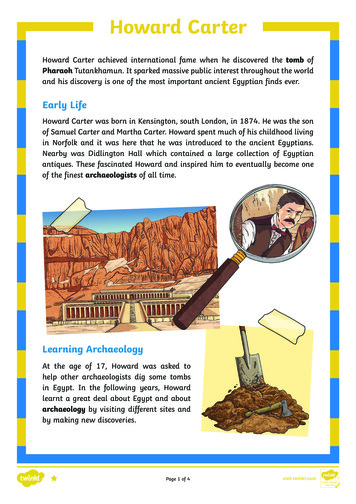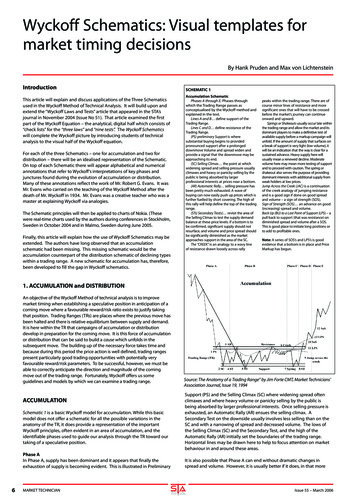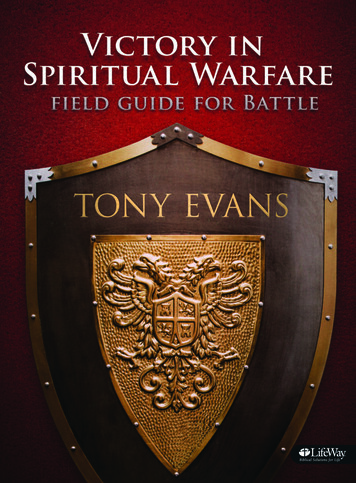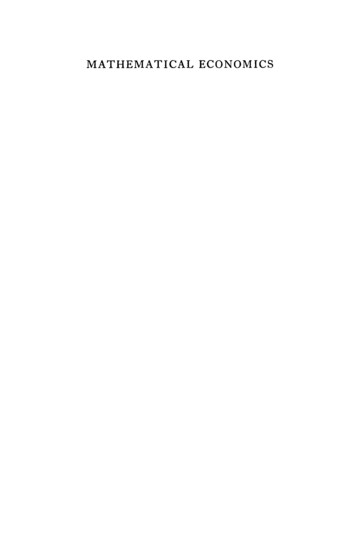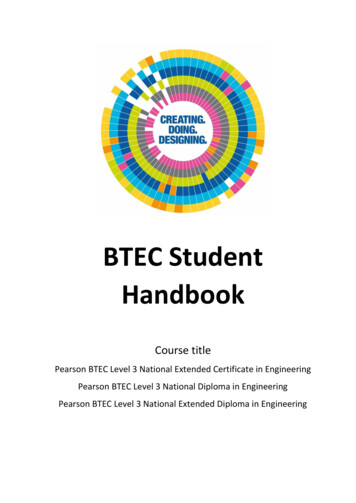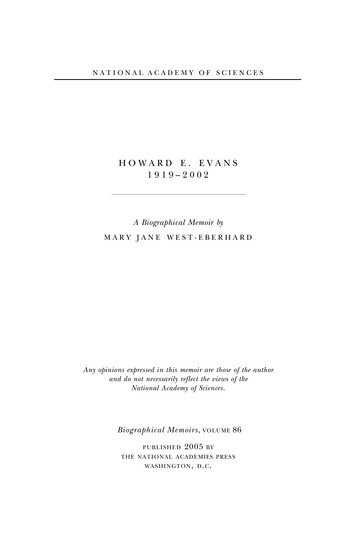
Transcription
NATIONAL ACADEMY OF SCIENCESHOWARD E. EVANS1919–2002A Biographical Memoir byMARY JANE WEST-EBERHARDAny opinions expressed in this memoir are those of the authorand do not necessarily reflect the views of theNational Academy of Sciences.Biographical Memoirs, VOLUME 86PUBLISHED2005BYT H E N A T I O N A L A C A D E M IES P R E S SWASHINGTON, D.C.
H O WA R D E . E VA N SFebruary 23, 1919–July 18, 2002BY MARY JANE WEST-EBERHARDHOWARD ENSIGN EVANS,one of the twentieth century’s leading entomologists and insect natural historians, wasborn in Hartford, Connecticut, the son of Archie JamesEvans and Adella Marian Ensign. He was also, in his sparetime, a talented writer of popular books and articles onnatural history and conservation.Howard Evans’s love of nature began on the Evans family farm near East Hartford, Connecticut, a 60-acre tobaccofarm that was purchased, with the help of financing fromhis maternal grandfather, Howard Ensign, when his parents were married. Howard’s mother was his father’s second wife. She had been teaching school after having studied education at a normal (state teachers’) school, andHoward was her only child, though he had a stepbrotherand three stepsisters by his father’s first marriage.In his childhood Howard Evans was strictly an appliedentomologist. Here is what he wrote about that stage in hislife.I suspect that when most people dig into the recesses of their minds fortheir earliest childhood memories they come up with scenes of kittens,puppies, or hamsters. My earliest memories are of tobacco hornworms, andhow delightfully they pop and ooze between bare toes. Picture a tobaccofarm in the Connecticut Valley, with kids walking up and down the rows3
4BIOGRAPHICAL MEMOIRSlooking for big, green caterpillars and executing them by the most primitive of control measures (Evans, 1985, p. 145).As a youth, Howard helped to found the HockanumNature Club, a museum in a woodshed with collections ofpressed leaves, wildflowers, birds’ eggs, and insects. Thename of the club came from the local American Indianname for the region of the Evans farm in East Hartford.Howard Evans undoubtedly had something to do with choosing the name, for later he often used indigenous words asnames for new species of insects discovered during his travels, for example, naming the Australian sand wasp Bembixmianga, a fly-catching species, after the aboriginal word(mianga) for “fly, ” and B. uloola, a bright orange species,after the aboriginal word, uloola, for “sun” (Evans andMatthews, 1973). His “first wealth (several dollars!)” camewhen he sold to a neighborhood hobbyist some of the mothsthat were attracted to the lights of the family fruit stand(Evans, 1968a, p. 25).Life on the farm was ended not by tobacco hornwormsbut by a series of hailstorms and a drop in the tobaccomarket that eventually drove Howard’s father to other cropsand eventually to bankruptcy during the Great Depressionof the 1930s. But his rural background was a lasting influence and inspiration. Even as an undergraduate Howardwrote, in a classroom essay on “Experiences With Insects,”I think the modern mind tends to debunk, or at least to minimize, thevalues and advantages of being country bred. . . . But I am sure that theappreciation of country life is merely going under a cloud, and will emergeagain when the people once more take to the country rather than swarming in the cities like flies on rotten fruit. . . . Although my family movedaway from the farm into the suburbs a few years ago, my absence from thecountry has tended to accentuate rather than suppress my affinity for thethings of nature. . . . My hobbies then were not the ordinary ones, such asstamp or coin collecting, but consisted of recording the living things I saw,
HOWARD E. EVANS5especially the birds, and, best of all, collecting insects. . . . I was an odd buthappy figure in those days, roaming the countryside with a net in one handand a pair of binoculars in the other. . . . I first became really interested ininsects when I began to notice the attractiveness of certain moths whichswarmed around the street lights. . . . The idea of making a net and ofmounting what I caught in boxes of cotton covered with glass was adoptedfrom a friend engaged in the same diversion. I soon became fanatic aboutthe business, and, much to my parents’ disgust, spent hour after hourchasing “bugs” over field and stream.Howard credited his father with his “workaholic tendencies,” and said that he was encouraged in his interest innatural history by his mother, who taught him the names ofmany birds, insects, and stars. Even so, when he went to theUniversity of Connecticut in 1936 he started out as an English major. He switched to biology after his first course inentomology, taught by J. A. Manter, described by Howardas “a very unusual teacher,” who “in his quiet way . . . introduced me to the world of professional entomology” (Evans,1968a, p. 25). After writing an undergraduate thesis on insects reared from the downed trees and branches of the1938 hurricane, he graduated magna cum laude in 1940.The intention to major in English probably reflected hislifelong passion for writing. His first book was a volume ofpoetry titled The Song I Sing (Evans, 1951), a compilationof poems previously published in the Hartford newspapers.During spare moments while later in the army he wrote anovel that he later destroyed. Throughout his active life asa scientist he wrote popular books, not all of them relatedto entomology. The best known of his 16 books, Life on aLittle-Known Planet (Evans, 1968a), was translated fromEnglish into French, German, and Japanese, and was reprinted many times during the more than 30 years that ithas remained in print. Unlike some popularizers of science,Evans did not lose respect in science as a result of his popu-
6BIOGRAPHICAL MEMOIRSlar writing, because his scientific output—a lifetime total of265 scientific publications, including a number of booksand monographs—was undiminished by his avocation as awriter for the general public. It was as if he led two highlyproductive lives in perfect harmony with each other.Immediately after college graduation Howard worked atthe Connecticut Agricultural Experiment Station in NewHaven, and then went to Cornell, where he completed amaster’s thesis on spider wasps (Pompilidae). Then, in December of 1941, while he and his mother listened to theNew York Philharmonic on the radio, indulging a love ofclassical music acquired while in college, he learned of theattack on Pearl Harbor. Howard asked his draft board tomove his name to the top of the list. He spent four years inthe army. Because he already had a master’s degree in entomology, he was assigned to be a medical laboratory technician in a hospital in Newfoundland, where he discoveredthat a mysterious ailment of servicemen was being causedby the parasite Giardia. Probably as a result of that discovery he was promoted to second lieutenant upon return tothe United States. He spent the rest of the war at a basehospital in North Carolina working as a parasitologist onstool samples from servicemen returning from the Philippines. In one of his books (Evans, 1985, p. 125), he said ofthis experience that “in a grim and odorous way, it wasrather fun.” Following this interlude of service in the armyhe was able to return to graduate studies at Cornell withoutfinancial problems, thanks to the GI bill. At Cornell, with J.Chester Bradley and V. S. L. Pate as cochairmen of hisdoctoral committee, he finished a doctoral thesis on thesystematics of the tribe Pompilini (Hymenoptera,Pompilidae), and then joined the faculty of Kansas StateUniversity in Manhattan, Kansas, as assistant professor ofentomology.
HOWARD E. EVANS7At Kansas State he taught courses on general entomology, immature insects, and morphology and curated theinsect collection (from an unpublished “History of the Department of Entomology, KSU,” by Herbert Knutson, deposited in the department; courtesy of John Reese). Therehe spent three productive years (1949-1952) studying thebehavior and systematics of sand wasps, along with his graduate students Carl Yoshimoto and C. S. Lin. During this timehe expanded his general interest in animal ethology withthe encouragement of a fellow faculty member, A. M. Guhl,a well-known student of social dominance in chickens, andread works by Lorenz, Tinbergen, Thorpe, and others.During this period, he also took a summer field trip toMexico with the late Paul D. Hurd, Jr., of the University ofCalifornia.Howard Evans and Mary Alice Dietrich were married in1954, soon after Mary Alice had finished her Ph.D. in science education at Cornell and not long after Howard hadreturned to work there as assistant professor of entomologyin 1952. They had three children, Barbara (Galloway), Dorothy (Tuthill), and Tim. Mary Alice was the daughter of theCornell entomologist Henry Dietrich, who had “warned hisdaughters to stay away from entomologists, who were likelyto be impecunious and little appreciated by society.” “Fortunately,” Howard wrote, “Mary Alice failed to take his advice” (Evans, 1985, p. 217). Howard declared in his autobiographical notes that “few persons have been lucky enoughto enter a partnership with someone so congenial and supportive.” He considered his marriage to Mary Alice his mainnot-exactly-scientific achievement, and meeting her in 1953“the most important (and fortunate) event in my life.” During the early years of their marriage the Evanses lived on 8acres of land on South Hill in Ithaca, New York, adjacent toButtermilk Falls State Park, a home that became the inspi-
8BIOGRAPHICAL MEMOIRSration for Wasp Farm (Evans, 1963), one of Howard’s mostsuccessful books and a nominee for the National Book Award.With Mary Alice as senior author, they wrote a 363-pagescholarly biography of Harvard entomologist William MortonWheeler (Evans and Evans, 1970), a major figure of earlytwentieth-century science, whose story as recounted in theEvanses’ biography gives a fascinating view of the issues,personages, and Old World influences that marked biologyin the United States at the turn of the twentieth century.I first met Howard Evans in 1966 when I was a graduatestudent. By that time he had moved from Cornell to Harvard,and I had an appointment to meet him in his office at theHarvard Museum of Comparative Zoology, the MCZ. I hadheard that Evans was shy and reserved, a man of few words.What if we would end up having nothing to say? I soonfound out that Howard Evans was the kindest and leastpretentious of men, and he was not the least bit shy when itcame to talking about insects. Later I learned that somepeople misinterpreted Howard’s shyness as snobbishness.One person told me that she had ridden with Howard onthe excruciatingly slow MCZ elevator many times over thespace of an entire year without Howard ever saying a singleword. He would just stare absently and wouldn’t smile orattempt small talk. Those who knew Howard well, especiallythose who spent time with him in the field, learned that hewas a person who was not embarrassed by silence.When I went to the MCZ as Howard’s postdoctoral associate in 1967 he was at the height of his productivity. Theyear before, 1966, had been what he later called his “banner year.” In that single year he authored 10 publications,totaling well over 1,000 pages. They included his now classic synthetic review on “The Behavior Patterns of SolitaryWasps” (Evans, 1966a), a 526-page book on The Comparative Ethology and Evolution of the Sand Wasps (Evans, 1966b),
HOWARD E. EVANS9and a 443-page monograph on the systematics of pompilidwasps (Evans, 1966c), an astounding list of achievementsfor one man in one year. In 1967 Howard was awarded theWilliam J. Walker Prize of the Boston Museum of Science,for contributions to natural history.In addition, he produced a constant stream of highquality popular works that did much to promote entomology and conservation in the public realm. He accomplishedthis prodigious output by dividing his workday strictly intotwo parts: While at the museum he did his “scientific” workand at home he did what he called his “literary work,” meaning work on the essays and books that were outside hismuseum duties. At home he often played recorded musicwhile working or relaxing. He would always leave his deskat the museum completely clear of clutter when he wenthome at the end of the day.Some think that Howard’s clean desk top was made possible by a set of messy drawers underneath, but I think itwas the same orderly discipline that enabled him to accomplish large amounts of work and writing without pause forthe 54 productive years spanned by his career. Whatever hissecret for rapid publication, Howard never seemed pressured or nervous. He always had time for students. He neverseemed too busy to write an encouraging letter to an amateur insect enthusiast, or to a kid hoping for a career inentomology.E. O. Wilson recently told me the following story fromthose days at Harvard. When Howard was in his office hesat hidden from view behind a high bookcase, and the department secretary worked at a desk on the other side, nearthe door to the collection. If you came for department business you never knew whether Howard was present on theother side of the bookshelf, and if he ever listened to whatwent on there, he never let on. Ed Wilson decided to put
10BIOGRAPHICAL MEMOIRSthis to the test by performing an experiment. He knew thatHoward and Mary Alice were working on their biography ofWheeler, and that they had spent hours interviewingWheeler’s daughter Adaline. But there weren’t many otherpeople still around who had known Wheeler. So, to testHoward’s quiet discretion, Ed walked in and said to thesecretary, in a squeaky imitation of a 95-year-old voice, “Iam a friend of Professor Wheeler, and I’d like to see him.”Howard instantly popped into view, revealing himself to beas much an eavesdropper as anybody else.Howard considered his move from Harvard to ColoradoState University in Fort Collins in 1973 as one of the bestthings he ever did. Tired of the long commute betweenhome and the museum, disillusioned with a new administration at the MCZ, and with good places for fieldwork diminishing in Massachusetts, the Evans family decided tomove. As Howard put it, they decided not to give Harvardtenure.Howard’s unpublished autobiographical essay, “A BriefReview of Scientific Accomplishments,” written when heturned 80 (in 1999), mentions that when the Evans familymoved to Colorado State, he actually accepted a nontenured position! He had already published 170 papers and 6books. Not surprisingly, he received tenure at CSU soonafter he arrived. At Harvard, Howard had only one graduate student, Robert Matthews (now a professor at the University of Georgia). At CSU he served as advisor for severalgraduate students, including the late Byron Alexander (aCSU master’s student who later studied with George Eickwortat Cornell), Darryl Gwynne, Mary Hathaway, Allan Hook,Rob Longair, Kevin O’Neill, and William Rubink. Threeyears after the move to Colorado, Howard was awarded theDaniel Giraud Elliot medal (in 1976) by the National Academy of Sciences, given for “recently published meritorious
HOWARD E. EVANS11work in zoology.” A year later he was elected to the National Academy of Sciences. Howard says in his essay thathe had “no illusions about these awards” and once in aletter he told me that he thought of dropping out of theAcademy, which he called “an elitist club” that wasn’t “hiscup of tea,” but that he kept his membership in the hopeof helping to elect other field biologists to the Academy.He did regard election to the Academy as an importantrecognition, however. With characteristic modesty he mentions in the unpublished “Autobiographical Notes” writtenfor his family that it was “an indication that I have donereasonably well as a scientist.” By that time, at the age of 80,he had described a total of 782 new species of insects, plus31 new genera, and even a new family: the Scolebythidae, afamily of wasps found in the Southern Hemisphere. Ten ofthe new genera are based on study of fossils.Evans was a pioneer in the use of behavioral data insystematics, and he proposed a number of important ideasthat I would call “transition hypotheses” showing how complex behaviors such as nest building, social life, and specialized prey transport could have evolved from hypothesizedancestral states. Along with phylogenies and adaptive explanations in terms of natural selection, such hypotheses establishing the feasibility of particular phenotypic changesare an essential part of evolutionary explanations. Amonghis publications Howard was most proud not of the theoretical ones but of those packed with new data on naturalhistory, such as his 1970 monograph on “Ecological-Behavioral Studies of the Wasps of Jackson Hole, Wyoming” (Evans,1970). “I have always been especially proud of that paper,”he wrote.Some of Howard’s ideas were far ahead of their time.He presented data on wasps that showed how behavior,including learning, could affect evolution, and he discussed
12BIOGRAPHICAL MEMOIRSthe general importance of this especially in his 1966 bookon sand wasps (see also Evans, 2002). Howard’s ideas onhow behavior can take the lead in evolution are now beingcited more frequently than before, as evolutionary biologists are increasingly aware of how the condition sensitivityof organisms can supplement the genetic study of evolution. Howard saw that connection long ago, and because ofit he wrote important critiques of overly gene-centered thinking, such as some analyses involving kin selection (e.g., seeEvans, 1977). One paper he considered underappreciateddescribed what he called dual sex-limited mimicry in SouthAmerican spider wasps (Pompilidae), where he showed thatin several species the males mimic social wasps, and femalesof the same species mimic tarantula hawks (Pepsis) (Evans,1968b).Howard Evans was never a powerful administrator or abiopolitician. He did not run a big lab bustling with technicians. He wasn’t a brilliant orator, and he didn’t hobnobwith the rich and famous. Yet he was a leader among biologists and had a deep influence on those who knew him. Heexerted a special kind of leadership in entomology becausehe stood for certain values in science and a certain kind ofdecency in human affairs. His way of promoting those values, aside from his personal interactions with the peoplearound him and the quality of his scientific work, was towrite clean, beautiful poetic prose that was at the sametime lighthearted and earnest and deep. Three things standout among the ideals that he promoted in both his scientific publications and his books and articles written for thegeneral public. First, he stood for a love of nature, for thehumble inhabitants of this planet, especially the insects,and he argued eloquently for their respect and preservation. Second, he stood for the value of curiosity-driven research, though it is worth mentioning that he never praised
HOWARD E. EVANS13pure science at the expense of the applied, for which hehad an equal respect. “Curiosity,” he wrote, “may have ‘killedthe cat,’ but it has nourished every good scientist” (Evans,1985, p. 23). Third, he defended the importance of research on natural history. He was incensed when he read ina book review that “biology is a system that proceeds frombiochemistry to the associated subjects of neurophysiologyand genetics. All else . . . is stamp collecting” (Evans, 1963,p. 149). “If this is so,” Howard wrote, “I can lay no claim tobeing a biologist . . . I find Darwin, Gray, and Fabre worthemulating in this twentieth century.” But Howard never allowed himself to be preachy and pedantic for very long. Inthe middle of this tirade about stamp collecting he says,“And it seems unfair to call me a stamp collector when Ican never remember what it costs to send a postcard.” WithHoward Evans, science was serious but it was never too serious; there was always room to lighten up.I was lucky enough to be working with this supremelyhumane man when I came up against the two greatest crises in the life of a woman in science: the birth of my firstbaby and the offer to my husband of an attractive job in aplace where there would of course be no formal job for me.A lesser advisor than Howard—or perhaps I should say onewith a less strong-minded wife than Mary Alice—might havegiven up on me then and there. But Howard never withdrew his support, even when I began to work mostly athome, and most of my projects began to lag, including mychapters for a book we were writing together on wasps (Evansand West-Eberhard, 1970). On the contrary, he recommendedboth my husband, William Eberhard, and me for a fellowship at a summer research station, even though we wouldbe going there directly from a maternity clinic; and he waitedwith seemingly endless patience for my chapters of our book.Howard always treated us with respect as a couple, reinforc-
14BIOGRAPHICAL MEMOIRSing our own natural optimism that we would both keepgoing in science, never turning his back when, in the eyesof others, the signs probably did not look too good.Howard Evans was legendary among entomologists forhis athletic prowess with an insect net. One of his students,Allan Hook, remembers that once while collecting at nightin Australia he and Evans were trying to catch some hawkmoths that were zipping up and down a trail. Allan couldn’tcome close to catching one even though he considers himself especially fast with a net, but Howard managed to getone. When he thrust his hand into the net to extract thespecimen, he exclaimed, “Hey, it’s hairy!” The elusive specimens were bats, and Howard was quick enough to catchone.After Howard retired from his position at Colorado Statein 1986, the Evanses moved to a beautiful mountain home35 miles from Fort Collins. At 7,800 feet it had a spectacular 50-mile view on all sides. The view did not completelydistract Howard from writing, and he completed five booksand many scientific articles after his retirement. He continued to do fieldwork, and taxonomic research on collections, throughout the rest of his life.Howard Evans’s approach to science and nature was mostcompletely stated in his book Life on a Little-Known Planet(1968a), where he concluded (p. 293), “The earth is a goodplace to live. We shall appreciate it more and more as weexplore the moon and the planets. If man shall ever haveanother home, it is presently unimaginable. We had betterlearn to respect the little-known planet beneath our feet.”Howard Evans departed this little-known planet on July18, 2002, at the age of 83, leaving life here a little betterknown than it was before he arrived. I think it is fair to saythat he was one of the finest entomologists of all time. Notonly was he the leading authority on the systematics of a
HOWARD E. EVANS15number of large groups of insects but he also publishedwidely on insect behavior, larval morphology, and insectpaleontology. His pioneer analyses of behavioral and biological data, published in the 1950s and 1960s, contributedto a major change in how systematics was done. HowardEvans was a shy and unsentimental man, a man who treasured fieldwork in remote and beautiful places far frompeople, and who often, in good humor, compared humansunfavorably with cockroaches and fleas. But at the conclusion of the autobiographical sketch he wrote in 1999 herefers to the “sterling people” he knew during his career inbiology, and says that knowing these people had been “thegreatest reward” of his professional life. He was a fine colleague and a warm friend who is not just missed but is alsoirreplaceable in the lives of those who depended on hismastery of broad areas of entomology and his eloquent enthusiasm for research in natural history. A complete list ofhis 265 scientific papers, 17 books, book reviews, and popular articles has been published elsewhere (West-Eberhard,2004).PARTS OF THIS essay were presented as a lecture in the symposium“Life on a Little-Known Planet: A Tribute to Howard Ensign Evans,”sponsored by the Entomological Society of America, Cincinnati, Ohio,on October 26, 2003. This biography is abstracted from a longerversion published in the Journal of the Kansas Entomological Society(West-Eberhard, 2004). Mary Alice Evans provided a copy of theunpublished scientific autobiography of Howard Evans written in1999, an essay of personal reminiscences written for his family in1986, and a complete list of his publications. Arnold Menke provided the frontispiece, dated 1968, from a collection of portraits ofnoted sphecidologists printed by the U.S. Department of Agriculture in 1974.
16BIOGRAPHICAL MEMOIRSREFERENCESEvans, H. E. 1951. The Song I Sing. Boston: Bruce Humphries.Evans, H. E. 1963. Wasp Farm. New York: Natural History Press,Doubleday. (Reprinted in paperback by Cornell University Press,1985.)Evans, H. E. 1966a. The behavior patterns of solitary wasps. Annu.Rev. Entomol. 11:123-154.Evans, H. E. 1966b. The Comparative Ethology and Evolution of the SandWasps. Cambridge, Mass.: Harvard University Press.Evans, H. E. 1966c. A revision of the Mexican and Central American spider wasps of the subfamily Pompilinae (Hymenoptera:Pompilidae). Memoirs of the American Entomological SocietyNo. 20.Evans, H. E. 1968a. Life on a Little-Known Planet. New York: Dutton.Evans, H. E. 1968b. Studies on neotropical Pompilidae (Hymenoptera).IV. Examples of dual sex-limited mimicry in Chirodamus. Psyche75:1-22.Evans, H. E. 1970. Ecological-behavioral studies of the wasp of Jackson Hole, Wyoming. Bull. Mus. Comp. Zool. 140:451-511.Evans, H. E. 1977. Extrinsic versus intrinsic factors in the evolutionof insect sociality. Bioscience 27:613-617.Evans, H. E. 1985. The Pleasures of Entomology. Washington, D.C.:Smithsonian Institution Press.Evans, H. E. 2002. A review of prey choice in bembicine sand wasps(Hymenoptera: Sphecidae). Neotrop. Entomol. 31(1):1-11.Evans, H. E., and R. W. Matthews. 1973. Systematics and nestingbehavior of Australian Bembix sand wasps (Hymenoptera, Sphecidae).Memoirs of the American Entomological Institute No. 20.Evans, H. E., and M. J. West-Eberhard. 1970. The Wasps. Ann Arbor:University of Michigan Press.Evans, M. A., and H. E. Evans. 1970. William Morton Wheeler, Biologist. Cambridge, Mass.: Harvard University Press.West-Eberhard, M. J. 2004. Howard E. Evans: Known and little-knownaspects of his life on the planet. J. Kansas Entomol. Soc. 77(4):296322.
HOWARD E. EVANS17SELECTED BIBLIOGRAPHY1950-1951A taxonomic study of the Nearctic spider wasps belonging to thetribe Pompilini (Hymenoptera: Pompilidae). Parts I, II, III. Trans.Am. Entomol. Soc. 75:133-270; 76:207-361; 77:203-340.1953Comparative ethology and the systematics of spider wasps. Syst. Zool.2:155-172.1955An ethological study of the digger wasp Bembecinus neglectus, with areview of the ethology of the genus. Behaviour 7:287-303.1956Studies on the larvae of digger wasps (Hymenoptera: Sphecidae).Part I. Sphecinae. Trans. Am. Entomol. Soc. 81:131-153.With C. S. Lin. Studies on the larvae of digger wasps (Hymenoptera:Sphecidae). Part II. Nyssoninae. Trans. Am. Entomol. Soc. 82:3566.1957Studies on the Comparative Ethology of Digger Wasps of the Genus Bembix.Ithaca, N.Y.: Cornell University Press.1958The evolution of social life in wasps. Proc. Xth Int. Congr. Entomol.2:449-457.1963The evolution of prey-carrying mechanisms in wasps. Evolution 16:468483.A new family of wasps. Psyche 70:7-16.1964The classification and evolution of digger wasps as suggested bylarval characters (Hymenoptera: Sphecoidea). Entomol. News 75:225237.
18BIOGRAPHICAL MEMOIRSA synopsis of the American Bethylidae (Hymenoptera, Aculeata).Bull. Mus. Comp. Zool. 132:1-222.1966The behavior patterns of solitary wasps. Annu. Rev. Entomol. 11:123154.A revision of the Mexican and Central American spider wasps of thesubfamily Pompilinae (Hymenoptera: Pompilidae). Memoirs ofthe American Entomological Society No. 20.The accessory burrows of digger wasps. Science 152:465-471.The Comparative Ethology and Evolution of the Sand Wasps. Cambridge,Mass.: Harvard University Press.1968Studies on neotropical Pompilidae (Hymenoptera). IV. Examplesof dual sex-limited mimicry in Chirodamus. Psyche 75:1-22.1970With M. A. Evans. William Morton Wheeler, Biologist. Cambridge, Mass.:Harvard University Press.Ecological-behavioral studies of the wasps of Jackson Hole, Wyoming. Bull. Mus. Comp. Zool. 140:451-511.1973With R. W. Matthews. Systematics and nesting behavior of Australian Bembix sand wasps (Hymenoptera, Sphecidae). Memoirs ofthe American Entomological Institute No. 20.1977Extrinsic versus intrinsic factors in the evolution of insect sociality.Bioscience 27:613-617.1978With K. M. O’Neil. Alternative mating strategies in the digger waspPhilanthus zebratus Cresson. Proc. Natl. Acad. Sci. U. S. A. 75:19011903.The Bethylidae of America north of Mexico. Memoirs of the American Entomological Society No. 27.
HOWARD E. EVANS191984With K. M. O’Neill. Alternative male mating tactics in Bembecinusquinquespinosus (Hymenoptera: Sphecidae): Correlations with sizeand color variation. Behav. Ecol. Sociobiol. 14:39-46.1986With A. W. Hook. Nesting behavior of Australian Cerceris diggerwasps, with special reference to nest reutilization and nest sharing (Hymenoptera, Sphecidae). Sociobiology 11:275-302.1996With A. Shimizu. The evolution of nest building and communalnesting in Ageniellini (Insecta: Hymenoptera: Pompilidae). J. Nat.Hist. 30:1633-1648.2002A review of prey choice in bembicine sand wasps (Hymenoptera:Sphecidae). Neotrop. Entomol. 31:1-11.
behavior and systematics of sand wasps, along with his gradu-ate students Carl Yoshimoto and C. S. Lin. During this time he expanded his general interest in animal ethology with the encouragement of a fellow faculty member, A. M. Guhl, a well-known student of social dominance in chickens, and read works by Lorenz, Tinbergen, Thorpe, and others.
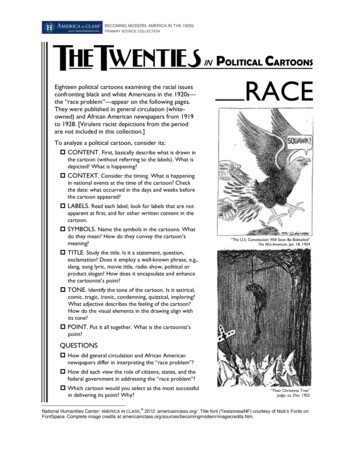

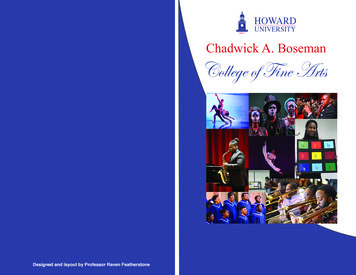
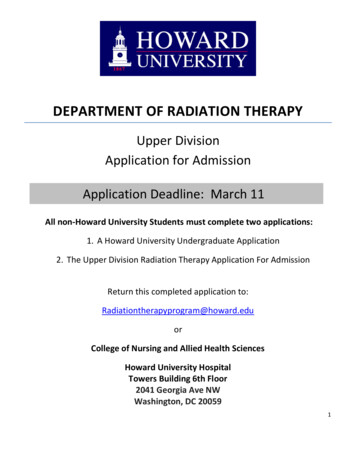
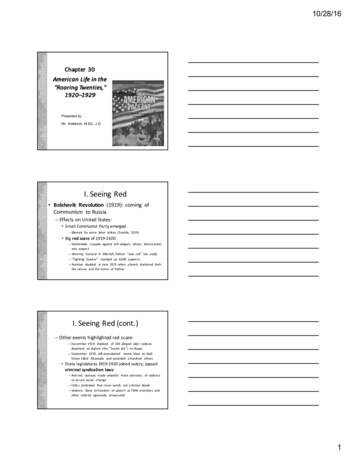
![The Book of the Damned, by Charles Fort, [1919], at sacred .](/img/24/book-of-the-damned.jpg)
